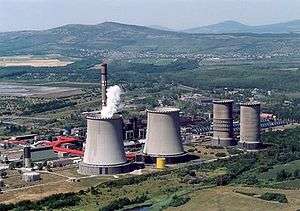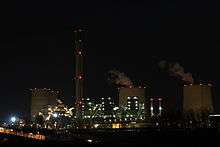Mátra Power Plant
| Mátra Power Plant | |
|---|---|
 | |
| Country | Hungary |
| Location | Visonta, Heves County |
| Coordinates | 47°47′25″N 20°3′45″E / 47.79028°N 20.06250°ECoordinates: 47°47′25″N 20°3′45″E / 47.79028°N 20.06250°E |
| Status | Operational |
| Construction began | 1965 |
| Commission date | 1969 |
| Owner(s) | RWE Power AG |
| Thermal power station | |
| Primary fuel | lignite |
| Power generation | |
| Units operational | 950 MW* 2 × 100 MW Lignite* 1 × 212 MW Lignite* 2 × 220 MW Lignite* 2 × 33 MW Gas |
|
Website http://www.mert.hu | |
Mátra Power Plant (Hungarian: Mátrai Erőmű Zrt.), is a lignite fired power plant owned by RWE. It is located in the valley of the Mátra mountains, Hungary.[1] It has an installed capacity of 950 MW, with expansion opportunities. The Power Plant is the second largest in Hungary (after Paks Nuclear Power Plant), providing about 15% of the country's electricity. It is considered an important pillar in the national energy sector, since production does not depend on imported fuels, but fully supplied from local resources. In 2012, Matra produced approximately 8.4 million tonnes of lignite.[2]
The chimney with a height of 203 meters is the 8th tallest buildings in Hungary.
History and Structure
The power plant has been operating for more than 40 years. The lignite is extracted from the opencast mines in Visonta and Bükkábrány. The original construction project was started in 1965, when lignite field was discovered near Gyöngyös. Between 1986 and 1992 the plant was first modernized. The company was then privatized and subsequently a controlling interest was acquired by RWE in 1995.[3] The entire power station required an upgrade and retrofit programme. As it emitted high levels of sulphur, flue-gas desulphurisation units were equipped to comply with EU emission standards. The units introduced were the first of their kind in the region, making the plant one of the most environmentally friendly coal-fired power plants in Europe.

Between 2005 and 2007, two of the 200 MW units were equipped with two topping gas turbines (TBT), each with a maximum of 33 MW capacity, which improved efficiency. The performance of the coal block increased by about 10%, which accounts for a total power output increase of about 100 MW. There were also plans for an additional block to be built, but in late 2010, the project was cancelled.[4]
References
- ↑ "EUROPA - Press Releases - European Commission approves "coal package" authorising restructuring plans for the Polish, German and Hungarian coal industry until 2010". Retrieved 2011-03-02.
- ↑ "Eurocoal Hungary profile". Retrieved 2014-11-10.
- ↑ "RWE extended the life of Hungary's Matra power station" (PDF). Retrieved 2014-11-10.
- ↑ "The new block has no future". Retrieved 2011-03-02.